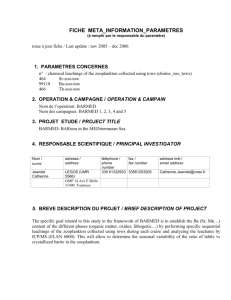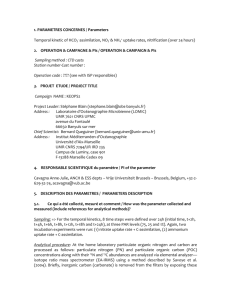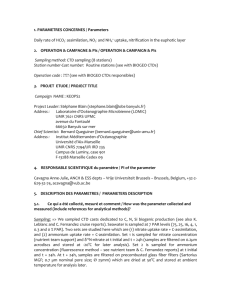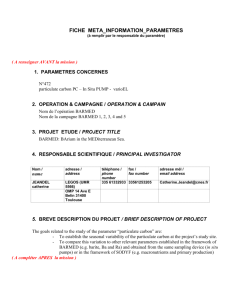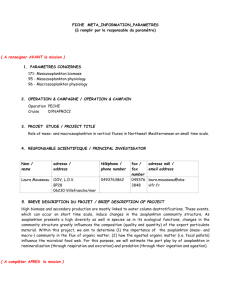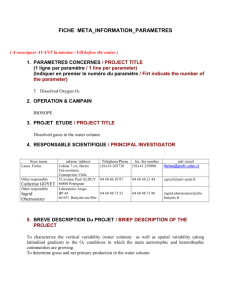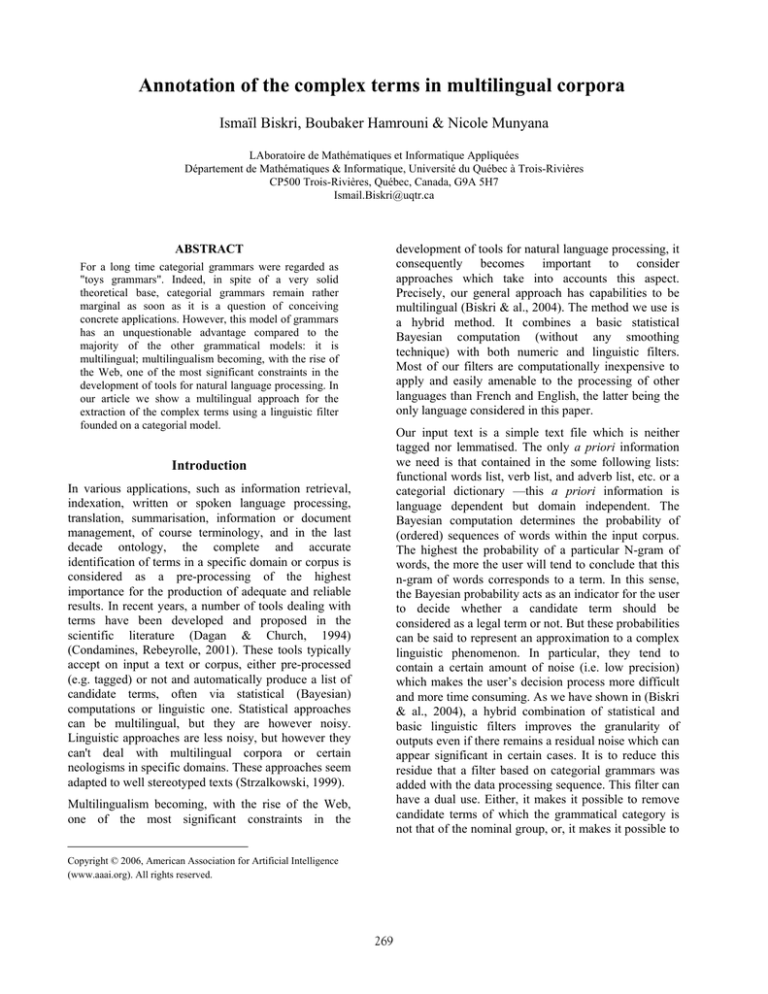
Annotation of the complex terms in multilingual corpora
Ismaïl Biskri, Boubaker Hamrouni & Nicole Munyana
LAboratoire de Mathématiques et Informatique Appliquées
Département de Mathématiques & Informatique, Université du Québec à Trois-Rivières
CP500 Trois-Rivières, Québec, Canada, G9A 5H7
Ismail.Biskri@uqtr.ca
development of tools for natural language processing, it
consequently becomes important to consider
approaches which take into accounts this aspect.
Precisely, our general approach has capabilities to be
multilingual (Biskri & al., 2004). The method we use is
a hybrid method. It combines a basic statistical
Bayesian computation (without any smoothing
technique) with both numeric and linguistic filters.
Most of our filters are computationally inexpensive to
apply and easily amenable to the processing of other
languages than French and English, the latter being the
only language considered in this paper.
ABSTRACT
For a long time categorial grammars were regarded as
"toys grammars". Indeed, in spite of a very solid
theoretical base, categorial grammars remain rather
marginal as soon as it is a question of conceiving
concrete applications. However, this model of grammars
has an unquestionable advantage compared to the
majority of the other grammatical models: it is
multilingual; multilingualism becoming, with the rise of
the Web, one of the most significant constraints in the
development of tools for natural language processing. In
our article we show a multilingual approach for the
extraction of the complex terms using a linguistic filter
founded on a categorial model.
Our input text is a simple text file which is neither
tagged nor lemmatised. The only a priori information
we need is that contained in the some following lists:
functional words list, verb list, and adverb list, etc. or a
categorial dictionary —this a priori information is
language dependent but domain independent. The
Bayesian computation determines the probability of
(ordered) sequences of words within the input corpus.
The highest the probability of a particular N-gram of
words, the more the user will tend to conclude that this
n-gram of words corresponds to a term. In this sense,
the Bayesian probability acts as an indicator for the user
to decide whether a candidate term should be
considered as a legal term or not. But these probabilities
can be said to represent an approximation to a complex
linguistic phenomenon. In particular, they tend to
contain a certain amount of noise (i.e. low precision)
which makes the user’s decision process more difficult
and more time consuming. As we have shown in (Biskri
& al., 2004), a hybrid combination of statistical and
basic linguistic filters improves the granularity of
outputs even if there remains a residual noise which can
appear significant in certain cases. It is to reduce this
residue that a filter based on categorial grammars was
added with the data processing sequence. This filter can
have a dual use. Either, it makes it possible to remove
candidate terms of which the grammatical category is
not that of the nominal group, or, it makes it possible to
Introduction
In various applications, such as information retrieval,
indexation, written or spoken language processing,
translation, summarisation, information or document
management, of course terminology, and in the last
decade ontology, the complete and accurate
identification of terms in a specific domain or corpus is
considered as a pre-processing of the highest
importance for the production of adequate and reliable
results. In recent years, a number of tools dealing with
terms have been developed and proposed in the
scientific literature (Dagan & Church, 1994)
(Condamines, Rebeyrolle, 2001). These tools typically
accept on input a text or corpus, either pre-processed
(e.g. tagged) or not and automatically produce a list of
candidate terms, often via statistical (Bayesian)
computations or linguistic one. Statistical approaches
can be multilingual, but they are however noisy.
Linguistic approaches are less noisy, but however they
can't deal with multilingual corpora or certain
neologisms in specific domains. These approaches seem
adapted to well stereotyped texts (Strzalkowski, 1999).
Multilingualism becoming, with the rise of the Web,
one of the most significant constraints in the
Copyright © 2006, American Association for Artificial Intelligence
(www.aaai.org). All rights reserved.
269
preserve candidate terms who could be removed by the
other filters. The input of this filter is a list of candidate
terms.
level are expressed. The genotype level uses a variablefree formal language, called Genotype Calculus, as its
formal framework. In this level functional semantic
interpretations are expressed by means of combinators,
which are abstract operators who allow constructing
more complex operators. According to (Curry and Feys
1958) each combinator is associated with to a βreduction rule. For instance, we present combinators B,
C, C*, with the following rules (U1, U2, U3 are typed
applicative expressions) :
We present in what follows the theoretical details of
this filter.
The model of Applicative and Combinatory
Categorial Grammar
The model of Applicative and Combinatory Categorial
Grammar (ACCG) falls under a paradigm of language
analysis that allows a complete abstraction of
grammatical structure from its linear representation due
to the linearity of the linguistic signs and a complete
abstraction of grammar from the lexicon. According to
the framework of Applicative and Cognitive Grammar
(Desclés 1990, 1996) and Applicative Universal
Grammar (Shaumyan 1998), the language analysis has
to postulate three levels of representation: Phenotype,
Genotype and cognitive levels (in this paper we are
interested only in the two first levels).
((B U1 U2) U3)
(((C U1) U2) U3)
((C* U1) U2)
Applicative and Combinatory Categorial Grammar
(ACCG), (Biskri and Desclés 1997), explicitly connects
phenotype expressions to its underlain representations
in the genotype (functional semantic interpretation). It,
like all Categorial Grammar models (Morrill 1994)
(Moorgat 1997) (Steedman 2000) (Dowty 2000),
assigns syntactical categories to each linguistic unit.
Syntactical categories are orientated types developed
from basic types and from two constructive operators
‘/’ and ‘\’. A linguistic unit 'u' with the functional type
X/Y (respectively X\Y) is considered as operator (or
function) whose typed operand Y is positioned on the
right (respectively on the left) of operator and the result
is of type X. In our paper, a linguistic unit u with
orientated type X will be designed by ‘[X : u]’.
In the phenotype level, particular characteristics of
natural languages are expressed (for example order of
words, morphological cases, etc...). The linguistic
expressions of this level are concatenated linguistic
units according to the syntagmatic rules of the language
concerned. We will write them as follows: lets u1, u2,
u3 linguistic units, their concatenation representation in
phenotype is u1 – u2 – u3.
In the genotype level, grammatical invariants and
structures that are underlying to sentences of phenotype
Let us provide now ACCG rules used in this paper.
Application rules :
[X/Y : u1] - [Y : u2]
---------------------------->
[X : (u1 u2)]
Permutation rules :
[(X\Y)/Z : u]
------------------------>C
[(X/Z)\Y : (C u)]
Functional
rules:
[X/Y : u1]-[Y/Z : u2]
------------------------->B
[X/Z : (B u1 u2)]
composition
–> (U1 (U2 U3))
–> ((U1 U2) U3)
–> (U2 U1)
The premises in each rule are concatenations of linguistic
units with orientated types considered as being operators
or operands, the consequence of each rule is an
applicative typed expression with an eventual
introduction of one combinator. The permutation of a unit
u introduces the combinator C; the composition of two
concatened units introduces the combinator B.
[Y : u1] - [X\Y : u2]
------------------------<
[X : (u2 u1)]
Since the aim of the approach we present here is to find in
a corpora the complex terms (nominal groups), it is not
useful to consider the type raising rule in the theoretical
formalism. This rule, initially, used to give an account for
the cases of coordination with ellipse (Steedman, 2000)
(Dowty, 2000), requires a whole set of meta-rules to
control its release (Biskri, Desclés, 1997). This rule
makes it possible, also, to choose a strategy of
270
incremental analysis “from left to right" (Biskri, Desclés,
1997). Our concern, here, is not to analyze coordination.
However, it appears significant to us to preserve an
analysis “from left to right" for reasons which we will
explain further. With this intention, the use of the
permutation rule is relevant. Indeed, this rule does not
require any meta-rule for its release on the one hand. On
the other hand, it allows a coherent analysis with a
strategy “from left to right”. In addition, from a technical
point of view, the combinator C, which is introduced in
the syntagmatic expression by the permutation rule, may
be equivalent to a combination of combinators C* and B,
respectively introduced in the syntagmatic expression by
type raising and composition rules. In fact, the following
combinatory expressions (a) and (b) are equivalent.
according to the theorem of Church-Rosser.
((C* Y) (X Z))
((X Z) Y)
The normal form of (a) is the same as the normal form of
(b). According to the theorem of Church-Rosser the
combinatory expressions (a) and (b) are then equivalent.
A full processing based upon Applicative and
Combinatory Categorial Grammar is carried out in three
main steps:
(i)
(ii)
(iii)
a) (((C X) Y) Z)
b) (((B (C* Y)) X) Z)
The first step is illustrated by the assignment
of categories to the linguistic units.
The second step is illustrated by the checking
of the proper syntactic connection. In other
words, here is checked the nominal phrase
nature of the candidate term.
The third step is illustrated by the
constructing of the normal form.
For instance let us consider the inferential calculation of
the following candidate terms (in french):
Indeed,
The β-reduction process of (a) is
(i)
(ii)
(iii)
(((C X) Y) Z)
((X Z) Y)
(iv)
The β-reduction process of (b) is
Base fondamentale (fundamental base);
Base de données (data base);
Base de données relationnelle (relational
data base);
Fondement de la théorie des nombres (base
of the theory of the numbers)
(((B (C* Y)) X) Z)
Example 1 :
1. [NP: base] - [NP\NP: fondamentale]
2. [NP: (fondamentale base)]
(<)
3. (fondamentale base)
Example 2 :
1. [NP: Base] – [(NP\NP)/N: de] – [N: données]
2. [NP: Base] – [(NP/N)\NP: (C de)] – [N: données]
3. [(NP/N) : ((C de) Base)] – [N: données]
4. [NP: (((C de) Base) données)]
(>C)
(<)
(>)
5. (((C de) Base) données)
6. ((de données) base)
C
Example 3 :
1. [NP: Base] – [(NP\NP)/N: de] – [N: données] – [N\N: multidimensionnelles]
2. [NP: Base] – [(NP/N)\NP: (C de)] – [N: données] – [N\N: multidimensionnelles]
3. [(NP/N) : ((C de) Base)] – [N: données] – [N\N: multidimensionnelles]
4. [NP: ((C de) Base) données)] – [N\N: multidimensionnelles]
271
(>C)
(<)
(>)
5. [(NP/N) : ((C de) Base)] – [N: données] – [N\N: multidimensionnelles]
6. [(NP/N) : ((C de) Base)] – [N: (multidimensionnelles données)]
7. [NP: (((C de) Base) (multidimensionnelles données))]
8. (((C de) Base) (multidimensionnelles données))
9. ((de (multidimensionnelles données)) Base)
(Structural Reorganisation)
(<)
(>)
C
Example 4 :
1. [NP: Base] – [(NP\NP)/NP: de] – [NP/N: la] – [N: théorie] – [(N\N)/N: des] – [N: nombres]
2. [NP: Base] – [(NP/NP)\NP: (C de)] – [NP/N: la] – [N: théorie] – [(N\N)/N: des] – [N: nombres]
(>C)
3. [(NP/NP) : ((C de) Base)] – [NP/N: la] – [N: théorie] – [(N\N)/N: des] – [N: nombres]
(<)
4. [(NP/N) : (B ((C de) Base) la)] – [N: théorie] – [(N\N)/N: des] – [N: nombres]
(>B)
5. [NP: ((B ((C de) Base) la) théorie)] – [(N\N)/N: des] – [N: nombres]
(>)
6. [(NP/N) : (B ((C de) Base) la)] – [N: théorie] – [(N\N)/N: des] – [N: nombres]
(Structural Reorganisation)
7. [(NP/N) : (B ((C de) Base) la)] – [N: théorie] – [(N/N)\N: (C des)] – [N: nombres]
(>C)
8. [(NP/N) : (B ((C de) Base) la)] – [(N/N) : ((C des) théorie)] – [N: nombres]
(<)
9. [(NP/N) : (B (B ((C de) Base) la) ((C des) théorie))] – [N: nombres]
(>B)
10. [NP: ((B (B ((C de) Base) la) ((C des) théorie)) nombres)]
(>)
11. ((B (B ((C de) Base) la) ((C des) théorie)) nombres)
12. ((B ((C de) Base) la) (((C des) théorie) nombres))
13. (((C de) Base) (la (((C des) théorie) nombres)))
14. ((de (la (((C des) théorie) nombres))) Base)
15. ((de (la ((des nombres) théorie))) Base)
B
B
C
C
All these candidate terms are of category NP. It is that
which the filter need to validate them. They follow certain
French patterns described in (Daille, 1994) (Sta, 1998):
term. For the second example the step 1 assigns categorial
types to linguistic units. Because the type of Base cannot
be composed with the type of de, this last one undergoes
in the step 2, an operation of permutation which
introduces the combinator C. Steps 3 and 4 respectively
operate the backward and the forward application rules.
The syntactic analysis “from left to right” raises the
problem of non-determinism introduced by the presence
in the language of backward modifiers that stand as
operators which are applied to the whole or a part of a
structure previously constructed. If, in the two first cases
the use of application and permutation rule allows the
analysis to be carried on, it is quite different for the third
and the fourth examples where the analyses “block”.
For a term like Base de données multidimensionnelles, the
parser at first creates the “spurious constituent” Base de
données (according to the meaning of the sentence). This
last
constituent
is
not
combinable
with
multidimensionnelles,
since
the
type
of
multidimensionnelles is N\N whereas the type of base de
données is N and no categorial rule can consequently be
applied. As a matter of fact, multidimensionnelles is an
operator whose operand données stands on its left. A
quasi-incremental analysis “from left to right” makes easy
the application of a combinatory categorial rule as soon as
possible. This factor gets as direct consequence to
“absorb” données into ((C de) Base) données), which
obviously does not allow us to directly construct
(multidimensionnelles données). That is to say, données
(i) Noun Adjective (example 1);
(ii) Noun “de” (Determiner) Noun (Example 2);
(iii) Noun “de” (Determiner) Noun Adjective
(example 3);
(iv) Noun “de” (Determiner) “la” (Determiner)
Noun “des” (Determiner) Noun (example 4).
Of course these patterns are not common for all the
languages. However, Applicative Combinatory Categorial
Grammar is suitable for other languages. If we have to
process for example English, we have just to get a
dictionary for English categories. We keep the same
categorial rules.
The analyses shown here are “from left to right”. This
kind of analyses eliminates the phenomenon of the
pseudo-ambiguity which consists in building several trees
of syntactic derivation which correspond to only one
semantic interpretation.
For the two first examples, no spurious constituent is
constructed. For the first example steps 1 and 2 are
applied in phenotype level whereas the step 3 is applied in
the genotype level. The expression obtained in the step 3
represents the functional form of the validated complex
272
does not appear clearly as the operand of the operator
multidimensionnelles.
then we can construct a new concatened expression
formed by both categories [X/Y:u1] and [Y:u2].
The same problem is observed with example 4 at step 5.
-
The raised problem comes back to the possibility of a
backtracking. But this backtracking is the kind one to
increase the “computational” cost (memory and time
execution) of one syntactic analysis. However, an
“intelligent” backtracking (that we will propose later on)
can allow us to reduce this cost considerably, and at the
same time by constructing proper semantic analyses and
by eliminating pseudo-ambiguities. So, such a
backtracking will decompose the constituent already
constructed in two components whose one of them may
be combined with the backward modifier.
Let us notice that the two rules (>dec) and (<dec) are
respectively inverse to the rules of functional application
(>) and (<). Both rules allow us to construct again a new
concatenated ordering of the structure operator/operand
coming from the reorganization.
For the statement Base de données multidimensionnelles
the decomposition is applied to the structure that arises
from reorganization: [NP: ((C de) Base) données)].
Formally, this operation of structural reorganization is
realized by the two following successive steps:
With the rule (>dec), we produce the concatenated
ordering: [(NP/N) : ((C de) Base)] - [N : données].
a- As shown elsewhere (Biskri, Desclés, 1997) the
reorganization of constituent already constructed isolates
two sub-categories at each time, and tests if the backward
modifier may "be combined on left" or not with one of
these two sub-categories. We then proceed to the
reduction of combinators until the test gives us a positive
value. At the end of the process we will recover a new
typed applicative structure “equivalent” to the first one.
We observe the same process which occurs at step 6 of
the analysis of the candidate term base de la théorie des
nombres. Indeed, the constituent ((B ((C de) Base) la)
théorie) is spurious since théorie is operand of the
modifier des nombres.
The most significant in our results is embodied, not only
in the validation of the complex terms but especially in
their functional structure. This one makes it possible to
construct the environment of use of a basic concept
represented by a word. In the analysed examples the word
base is seen modified by several expressions which act as
an adjective and which determine the context of its use.
We can, in this way, systematize, for instance, the
extraction of relations which could generalize the concept
of hyperonymy or hyponymy. With this intention, the
management of a complete semantic graph becomes
necessary. In such a graph nodes can represent words and
edges can contain features to categorize the relations
between the nodes.
Example: In the case of the statement Base de données
multidimensionnelle, the steps of reorganization are :
Constituent constructed:
[NP : ((C de) Base) données)]
The two sub-categories are :
[(NP/N) : ((C de) Base)] ; [N : données]
données can be composed with multidimensionnelles.
Hence, no need in this case to combinators reduction
process. We recover the category in output:
[NP : ((C de) Base) données)].
Conclusion
We have presented in our paper a linguistic filter
integrated to a semi-automatic software tool for complex
terms identification. Our filter is different from most other
terms identification linguistic filters in that:
b- Decomposition realized by means of the two rules:
[X : (u1 u2)]
---------------------->dec ;
[X/Y : u1]-[Y : u2]
[X : (u1 u2)]
----------------------<dec
[Y : u2]-[X\Y : u1]
•
We read these rules as following:
-
For (<dec): If we have an applicative structure (u1
u2) with type X, u1 of type X\Y and u2 of type Y,
then we can construct a new concatened expression
formed by both categories [Y:u2] and [X\Y:u1].
For (>dec): If we have an applicative structure (u1
u2) with type X, u1 of type X/Y and u2 of type Y,
273
It tends to be multilingual. With the growth of
the Web and of the multilingual textual data
bases, this aspect is significant. All what we need
to adapt the approach to a new language is
another dictionary of categorial types with the
lexical entries of this language
•
Naturales y Lenguajes Formales, XII, Universitat Rovra i
Virgili. , 29-60.
A solid logical and linguistic theory supports the
approach. This theory is particularly flexible. In
certain cases the complex terms can be of which
the grammatical category of verbal phrase. It
would be enough then to consider that the
complex terms to validate have the categorial
types specific to the verbal phrases.
Desclés, J. P, (1990). Langages applicatifs, langues
naturelles et cognition, Hermes, Paris.
Dowty, D., (2000), The Dual
Adjuncts/Complements in Categorial
Linguistics 17.
Analysis
Grammar.
of
In
Moorgat, M., (1997). Categorial Type Logics. In Johan
Van Benthem and Alice Ter Meulen eds., Handbook of
Logic and Language, 93-177. Amsterdam: North Holland.
Acknowledgements
This research was supported by the Natural Sciences and
Engineering Research Council of Canada (NSERC).
Morrill, G., (1994), Type-Logical Grammar. Dordrecht:
Kluwer.
Shaumyan, S. K., (1998). Two Paradigms Of Linguistics:
The Semiotic Versus Non-Semiotic Paradigm. In Web
Journal of Formal, Computational and Cognitive
Linguistics.
References
Biskri, I., Descles, J.P., (1997), "Applicative and
Combinatory Categorial Grammar (from syntax to
functional semantics)", in Recent Advances in Natural
Language Processing (selected Papers of RANLP 95) Ed.
Ruslan Mitkov & Nicolas Nicolov. John Benjamins
Publishing Company, Numéro 136, pages 71-84.
Sta, J.D. (1998), "Automatic acquisition of terminological
relations from a corpus for query expansion". Proceedings
of the 21st annual international ACM SIGIR conference
on Research and development in information retrieval,
p.371-372, August 24-28, 1998, Melbourne, Australia
Biskri, I., Meunier, J.G., Joyal, S., (2004), "L'extraction
des termes complexes : une approche modulaire semiautomatique" Dans Le Poids des mots (Actes des 7èmes
Journées Internationales d'Analyse Statistique des
Données Textuelles, Louvain-La-Neuve, Belgique),
Gérard Purnelle, Cédrick Fairon & Anne Dister (eds).
Presses Universitaires de Louvain, Volume 1, pp 192201, ISBN 2-930344-49-0.
Steedman, M. (2000). The Syntactic Process, MIT
Press/Bradford Books.
Srzalkowski, T. (1999). Ed., Natural Language
Information Retrieval, Kluwer Academic Publishers.
Condamines, A., Rebeyrolle, J. (2001), "Searching for
and identifying conceptual relationships via a corpusbased approach to Terminological Knowledge Base
(CTKB)", in D. Bourigault, C. Jacquemin & M.-C.
L’Homme (eds), Recent Advances in Computational
Terminology, Amsterdam/Philadelphia, John Benjamins
Publishing Company, pp. 128-148.
Curry, B. H., Feys, R., (1958). Combinatory logic , Vol. I,
North-Holland.
Dagan I., Church, K. (1994). “Termight : Identifying and
Translating Technical Terminology”, Proceeding of the
Fourth Conference on Applied Natural Language
Processing, Association for Computational Linguistics,
Stuttgart, Germany, 13-15 October 1994, 34--40.
Daille, B. (1994). “Study and Implementation of
Combined Techniques for Automatic Extraction of
Terminology”, Proceedings of the Combining Symbolic
and Statistical Approaches to Language Workshop (the
Balancing Act), Las Cruces (New Mexico), USA, 1st July
1994, 29--36.
Desclés, J.P., (1996). Cognitive and Applicative
Grammar: an Overview. in C. Martin Vide, ed. Lenguajes
274

